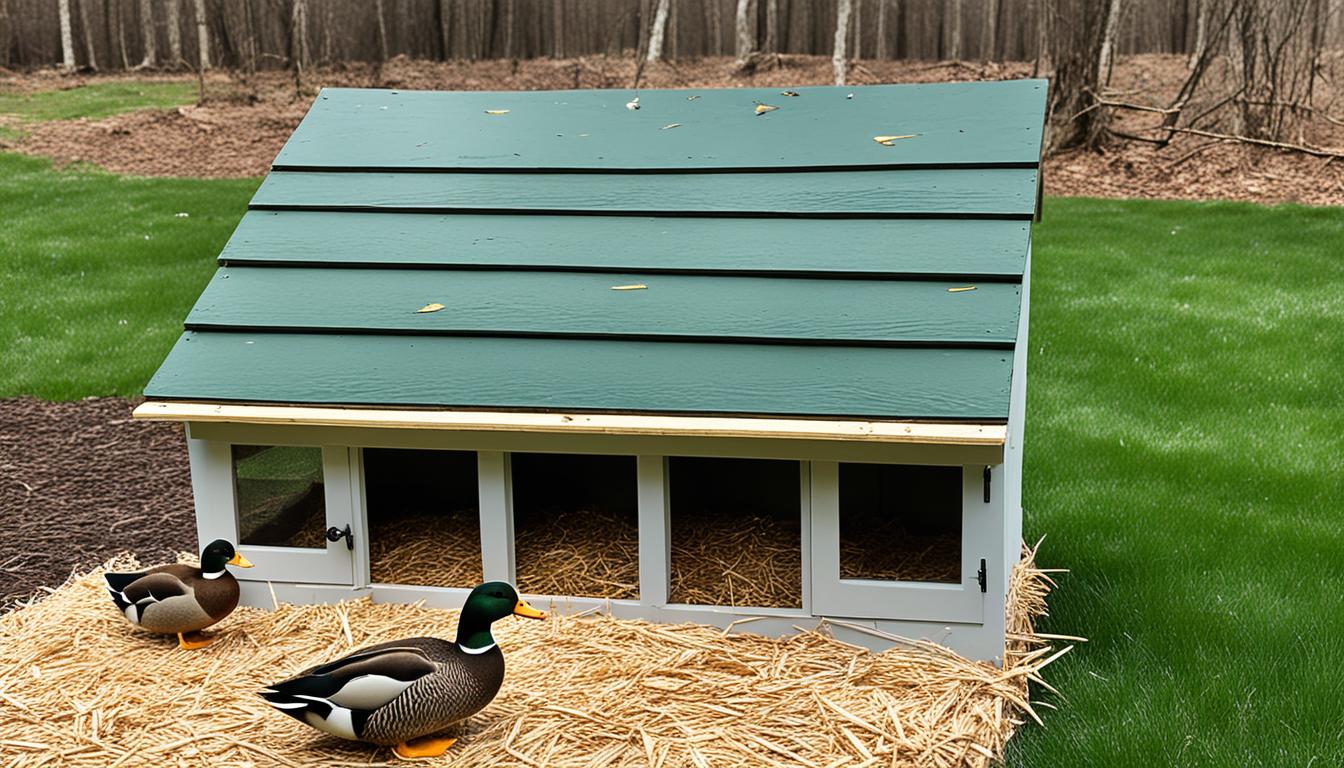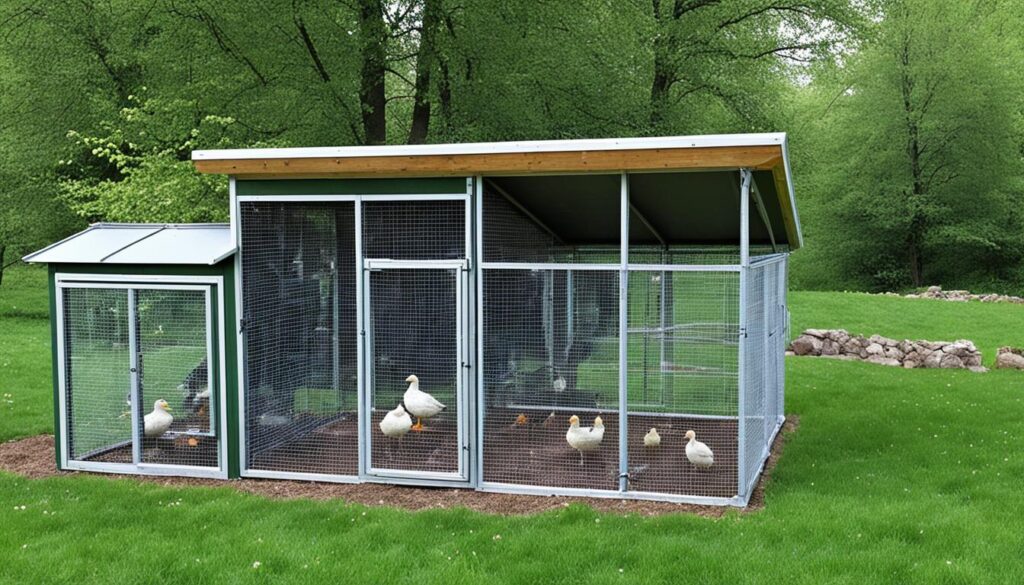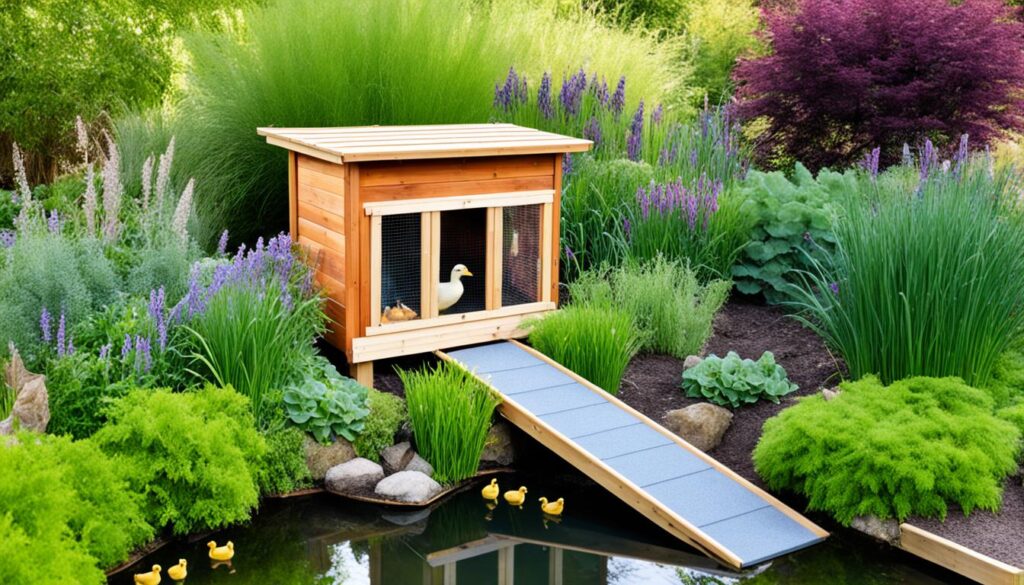When making a duck coop, you need to think about a few key things. Ducks don’t need a big house, but they do need a safe place. It’s best to keep ducks and chickens in separate homes to stay dry and healthy. For ducks, a flat sleeping area is fine, but they need a big enough space. A 3-foot-high wooden box or old dog house is good, with 4 square feet for each duck. They should also have at least 10 square feet outdoors, but 20 is better.
The door for a duck house should be big, about 14 by 12-14 inches. Ducks are big and not as graceful on land, so they need enough room to get in easily. You can use scrap wood to build the coop and save money. A good size for a basic duck house is 2 by 4 feet, standing 4 feet tall.
Duck houses need good air flow to keep the air dry. Duck droppings can spread more than those of chickens. Viny tiles on the floor and lower walls make cleaning easier and prevent wood damage. Painting your duck coop makes it look nice. Ducks like the cold more and may choose to sleep outside. This is why a door for them to come and go is important.
Key Takeaways:
- Ducks need a minimum of 4 square feet of floor space per duck in their coop.
- Ducks need a minimum of 10 square feet of secure outside space per duck, with 20 square feet per duck being more ideal.
- The door size for a duck house should be about 14 inches wide and 12-14 inches tall.
- Building a duck house entirely out of scrap wood can be a cost-effective method.
- Adequate ventilation is crucial in a duck house to allow for the escape of moisture.
- Using vinyl tiles for the floor and lower wall sections can aid in easier cleanup and protect the wood from rotting.
- Ducks are more cold-hardy than chickens and may prefer sleeping outside or having access to the outdoors at night.
Design Considerations for a Duck Coop
When making a duck coop, think about what ducks need to be happy and healthy. They need lots of room, water, and good air flow. This helps them do well.
- Size: Make the coop big and plan for growth. Each duck should have at least 4 square feet of space. Since ducks can have many babies, plenty of room is a must.
- Cleaning: Making it easy to clean is key. Big doors and many ways in help. Put down vinyl tiles on the floor. This makes messes easier to clean and the coop lasts longer.
- Separate Space: Chickens and ducks should not share a coop. Chickens like it dry, but ducks are messy and need wet areas. So, keep their homes apart.
- Ventilation: For fresh air, use hardware cloth on openings. Ducks make the air damp, which can lead to bad smells and mold. Ventilation helps keep the air fresh and healthy.
- Drainage: Include good drainage inside. Ducks need water all the time. Having a good system means less work for you and happier ducks.
- No Nesting Boxes: Ducks don’t need nesting boxes like chickens do. They lay eggs where they want.
- Easy Access: Make sure ducks can get in and out easily. The door should be low to the ground. This makes life easier for them.
Getting advice from duck experts or other duck owners is smart. They can give you more tips. By following these design ideas, you’ll build a duck coop that’s perfect for your feathery friends. It will keep them healthy and happy.
Building a Duck Coop on a Budget
You can build a duck coop without spending a lot. With some innovative thinking and using what you have, making a cheap duck coop is totally doable. This approach not only saves you money but is good for the planet.
Use old wood or pallets for the duck coop’s frame. Then, cover it with plywood or small wood pieces. This step will give your ducks a place that’s safe and sound. For the roof, go for corrugated panels because they’re budget-friendly and lightweight.
Building with an eye for detail is key. Make sure to add trim and sealant to close gaps and keep your ducks cozy. It’s also wise to use vinyl tiles for the floor and walls. They make cleaning easy and reduce the risk of wood rot.
Making your coop look good matters too. Use paint made for the outdoors. This step not only makes the coop pretty but also protects the wood. Pick a color that makes your yard look even better.
If you have both ducks and chickens, set up separate areas for them inside. Use 2x4s and chicken wire. This way, they can be together but with their own space.
Start with a strong foundation for your coop. Use cinder blocks or something else that’s steady. The right frame is crucial to keep everything up and going.
Adding windows up high on the coop’s sides is a smart move. This helps fresh air in and bad smells out. It’s all about making a safer space for your ducks.
For the coop’s hardware, choose galvanized hinges and bolts. They last longer outdoors. This makes your duck coop more secure too.
Building a budget-friendly duck coop means being smart, not cutting corners. Use what you can find to save money. But always think about your ducks’ safety and comfort. With a bit of imagination and effort, you can build a fine duck coop.
Tips and Tricks for Duck Coop Construction
Building a duck coop requires careful thought and planning. It’s key to consider various tips to make sure your ducks are happy and safe. By following these steps, you can create a perfect home for your ducks.
1. Plan According to Duck Population and Growth
Think about how many ducks you have now and might have later. Each duck needs at least 4 square feet of space in the coop. Plan ahead to avoid big changes later.
2. Prioritize Proper Ventilation
Ducks make a lot of wet poop, so keeping the air fresh is very important. Your coop should have enough openings or windows for the air to flow through. But, these openings must be secure against predators.
3. Use Suitable Materials
Choosing the right materials is vital for a strong duck coop. Things like plywood, pallets, and corrugated roof panels work well. They are sturdy and cost-effective.
4. Build the Coop at Ground Level
Ducks can’t climb well, unlike chickens. So, it’s smart to keep their coop low to the ground. This makes it easy for them to get in and out without getting hurt.
5. Train Ducks to Use the Coop
Making your ducks use the coop means starting early. Herd them into the coop every night for the first few weeks. This way, ducks learn to use it for sleeping safely.
6. Consider Water and Feed Bowl Placement
Where you put food and water in the coop matters a lot. Ducks can be messy. Pick a spot that’s easy for them to get to and clean up daily.
7. Protect Your Coop with Paint or Stain
Painting or staining your duck coop does more than make it look good. It also protects it from the weather. Choose a color that looks good in your yard.
8. Ensure Stability and Protection
Your coop needs to be strong and well-made. Make sure it’s secure and won’t fall apart. Provide enough ventilation and keep it warm with straw in winter.
These tips will help you build a cozy and safe space for your ducks. Happy building!
Conclusion
Building a duck coop is crucial for your ducks’ safety and comfort. It’s important to think about shelter, space, ventilation, and keeping them safe from predators. This ensures you make a great home for your ducks.
Your duck coop must be planned carefully. Ducks need their own space to stay healthy. Remember, each duck needs between 2 to 6 square feet indoors. Larger ducks might need a bit more room.
Ventilation is key, especially in hot weather. It helps keep the ducks cool and cuts down on moisture. It’s also vital to protect the coop from predators like possums and raccoons. Use strong materials and good fencing to keep your ducks safe.
You don’t need a lot of money to build a duck coop. You can use scrap wood and other found materials to keep the cost low. With the right planning and tools like a miter saw, you can craft a coop that’s both affordable and long-lasting.


